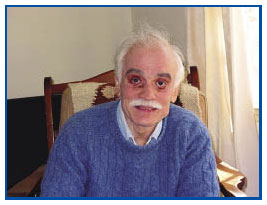Prof. Mahendra Kumar Jain, biochemist and philosopher who joined the faculty in 1973 and quietly went on to become one of the most published, most cited, and most highly recognized faculty members in the Department, is retiring. His primary recognition is in the area of interfacial catalysis, in particular, translating the well-known three-dimensional solution kinetics of Michaelis-Menten into the two-dimensions of interfacial catalysis where enzymes operate on membranes. Over the years, he and a small number of coworkers have analyzed the kinetics of the enzyme phospholipase A2 in great detail to document and test the interfacial model and elaborate how enzymes “scoot” or “hop” on a membrane surface. Mahendra also has exploited his early training in the chemistry of natural products to identify and study ajoene, the active antiplatelet compound in cooked garlic, and has discovered a potent natural inhibitor of phospholipase A2.
Born in India where he was educated through the master’s degree and became a lecturer at Punjabi University, Mahendra went on to the Weizmann Institute in Israel where (within 18 months!) he received a Ph.D in Organic Chemistry with David Lavie. From there, he moved to Indiana University in Bloomington as a research associate with Eugene Cordes for six years before coming to the University of Delaware. At Indiana, he became an expert on membranes and published a book, The Bimolecular Lipid Membranes: A System. Shortly after coming to Delaware, Mahendra, with colleague Roger Wagner in the Biology Department, published a widely-used text, Introduction to Membranes, was sole author on a revised and updated edition of the text, and was author of a Handbook of Enzyme Inhibitors. More recently, he published Interfacial Enzyme Kinetics with Otto Berg. He has taken sabbatical leaves in the Netherlands, Germany, and India.
Throughout his career Mahendra has been supported by NIH grants and supplemented with grants from NSF and industrial sources. In contrast to the research style of most academic scientists who sooner or later leave the bench and rely on graduate students to do experiments, Mahendra has always spent a substantial amount of time in the laboratory working with a few research associates and talented undergraduates. His work style also shows the importance of collaboration. Coauthors on his publications include 10 faculty colleagues and close collaborators from across the country and around the globe.
In recent years and in his spare time, Mahendra has continued the work of his father in translating and interpreting ancient Indian Prakrit texts on logic into modern language. These studies, which are published on-line <http://www.hira-pub.org/> relate to the nature of valid perception, the significance of doubt, and the role of language in the search for meaning. They lay out a consistent way of reasoning. While these studies may seem far removed from interfacial catalysis, they are in fact quite relevant because they define an approach to understanding the natural world through systematic analysis of the evidence that logically entertains doubt - an approach that Mahendra has followed throughout his scientific career.
Colleagues hope that Mahendra won’t stray too far from Newark in retirement because they would like to continue the casual but wide-ranging and stimulating intellectual discussions with him over a meal (with garlic) at a local restaurant.
- Harold B. White

